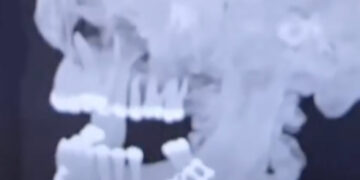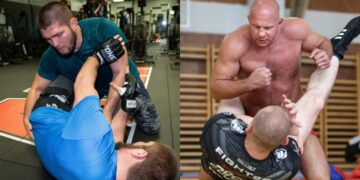
There are different ways to pass the guard in BJJ. Some grapplers prefer to pass while standing, kneeling, and utilizing speed or pressure-based passes. Another strategy is by forcing the opponents into certain positions like the half guard. Most importantly, it’s best to develop a passing system that suits your style to stay ahead of your opponents, giving them an answer for every reaction they present in the different scenarios you create. In this article, we’ll delve deep into understanding headquarters passing in BJJ.
What Is The Headquarters Position?
The headquarters position occurs when the guard passer is on top of the opponent’s leg (shin) in an open guard position, with the opponent’s leg trapped between their legs. It is usually established when the passer splits the opponent’s guard and clears the opponent’s feet from their hips or upper body. By entering this position, the guard passer neutralizes the threat of modern guards like the De La Riva, Lasso, and Spider, as well as the danger of leg entanglements. Aiming for the headquarters allows grapplers to combine different guard passes and transitions, making building a robust open guard passing system a viable option to incorporate into one’s game.
The Value Of The Headquarters Position
The headquarters position accomplishes one of the essential elements of guard passing: bypassing the opponent’s feet, which serve as their primary line of defense. Bypassing the opponent’s feet allows the guard passer to move beyond the initial defensive barrier, putting them closer to the end goal of controlling the hips. Moving past the opponent’s feet keeps the guard passer safe from specific sweeps and submissions, putting the passer in a position to initiate a variety of mid-range guard passing attacks such as the knee slice, long step, X pass, and others.
The headquarters, reverse De La Riva, and half guard are all similar positions, with only slight differences in distance. Consider the headquarters as a safe spot. By clearing the bottom player’s feet, the guard passer is in a relatively safer position and is also within the distance of the guard pass, as generally speaking, allowing the guard players to place their feet on you comes with risks. Being in the headquarters limits the opponent’s hip mobility, and when passing the guard, remember that the opponent’s line of defense is their feet, knees, and hips. The feet are the first and most important line of defense, allowing the opponent to create distance as frames. The knees and hands are also used to frame the opponent from coming closer than they already are, but the feet can prevent guard passes by pushing the guard passer away.
Passing From The Headquarters Position
When passing the guard, the first thing a passer has to deal with is the feet, and the headquarters can be used to address them. A great example of getting to the headquarters position is from the De La Riva guard. As the opponent assumes the DLR guard, break their grips and use your hands to grab their shins. Drive in and lower your body weight as you extend your arms (stiff arm). Maintain the DLR hook as you lift your hips and pop back to remove the DLR hook. Step back and pull the opponent’s leg as you step over. Pinch your knees to trap their leg and squat back to secure the position.
The headquarters position occurs when you straddle the opponent’s leg. In this position, you aim to align with the opponent’s trapped leg; think about aligning your spine with the opponent’s shin. From here, you have sufficient weight that the opponent can’t simply elevate you using their trapped leg as you’re not leaning over them.
Assuming the opponent’s right leg is trapped, use your right shin to pin their left leg down. Utilize your hands for hand fighting to control the opponent’s hands or head. How you pass from this position is determined by several factors, such as how high the opponent’s knee is in front of you, how deep their foot is behind you, and the direction of their shin relative to your spine.
If the opponent has enough of their foot protruding towards your glute, you can overcome them by placing both hands on the mat above their shoulders. If you have the opponent’s right leg trapped, execute a pummel by kicking your left foot toward your glute and hooking your ankle around the opponent’s right ankle. Pike your hips as if performing a handstand, enough to clear your pelvis above the opponent’s right knee, and pass straight to the mount position.
When you reach the leg pummel position, and there’s no room to hook your ankle above the opponent’s ankle because their foot is too close to your glute, consider the positioning of their knee. If the opponent’s right knee is facing outward, thus misaligned with your spine, opt for the knee cut. Pull back and slide your right hand under the opponent’s left armpit, moving from being on top of their shoulder to create an underhook. Slide your right leg across the opponent’s right leg (trapped leg) and cut through to complete the knee cut pass. This maneuver requires finesse and an understanding of body positioning to execute effectively.
Conversely, if the opponent’s right knee is pointing inward (towards the opponent’s left side), the reverse knee cut becomes a viable option. In this scenario, maneuver your left leg behind the opponent’s right leg and cut over their left leg (far leg), while your right leg stabilizes on the mat. Keeping your left knee close to the opponent’s left hip is crucial to prevent them from creating space and pushing you away. This variation of the knee cut pass focuses on using your body’s movement and positioning to bypass the opponent’s defenses.
Transitioning from these positions requires understanding the opponent’s potential reactions and the ability to adapt on the fly. Control becomes paramount; using head and arm pressure to compress the opponent’s upper body can significantly reduce their ability to resist or counter your passes. Additionally, effectively maneuvering your right leg around the opponent’s blocking leg clears the path to more dominant positions such as mount or side control.
The art of passing from the headquarters position in Brazilian Jiu-Jitsu encapsulates the essence of the sport: a chess match of physical prowess, strategic positioning, and mental acuity. For practitioners aiming to refine their guard passing game, the headquarters offers a launchpad for various techniques tailored to overcoming the guard player’s defenses. It underscores the importance of building a coherent system of guard passing that aligns with one’s personal style and the dynamic nature of BJJ and its engagements
Conclusion
The headquarters position in BJJ is not just a technique but a principle – a way of approaching the guard passing game that emphasizes control, versatility, and strategic foresight. As practitioners develop their skills and integrate the headquarters into their repertoire, they begin to see guard passing not merely as a challenge to be overcome but as an opportunity to express their understanding of BJJ’s profound tactical depth.
For those dedicated to enhancing their guard passing, the journey involves continuous practice, keen observation, and the willingness to experiment with techniques and transitions. With its foundational importance and adaptability, the headquarters pass serves as an essential component of this journey.
You may also like:
6 Most Efficient Guards For Older Grapplers In Brazilian Jiu-Jitsu
Brazilian Jiu-Jitsu (BJJ) is a grappling-based martial art and a form of self-defense originating from Brazil. It was created by the Gracie brothers after they modified techniques and philosophy from Japanese Jujutsu. Brazilian Jiu-Jitsu focuses on ground fighting and…
Brazilian Jiu-Jitsu is one of the few martial arts out there that stays highly effective regardless of one’s physical ability. The secret to this is that it’s not about overpowering your opponent with sheer strength…
School can be a strenuous time for children, especially given the rough demands of constant studying and the pressure of attaining high marks. Yet it’s something that everyone goes through early on in their lives….
Brazilian Jiu-Jitsu is a grappling martial art that emphasizes ground fighting and submissions. One of the critical aspects of BJJ is the ability to pass the guard – a position where one fighter is on…
In Brazilian Jiu-Jitsu, you must isolate the limb you are attacking to submit an opponent effectively. The same can be said when passing the guard. Typically, to pass the guard, a grappler must be able…
As Brazilian Jiu-Jitsu evolves, the guard and guard passing are constantly in a race to get ahead of each other. Innovative ways to play the guard and connect them with other guards to enter leg…
Boxing is an intense martial art that improves your physical and mental well-being. It gives you a full-body workout that engages every muscle in your body, and it forces your heart and lungs to work…
We all know that being a new parent is one of the most challenging things you’ll ever do. Your little bundle of joy needs a lot of tender loving care, and the more help, the…
Trying to create a “best” list is a tough challenge for any sport. You can include athletes who have the most wins on their records and the ones who have captured the most accolades, but…
Your waking hours involve making movements that engage different joints and muscle groups at the same time. Take a day when you need to catch a flight for a short trip. First, you’ll put your…
The Soviet boxing style was created during the days of the Soviet Union and revolves around strategic footwork, precise combinations, high-fight IQ, and keeping opponents at range. It’s a technique-driven boxing style that prioritizes fighting…
Did you know that cross-training helps martial arts practitioners work out more efficiently? Cross-training involves mixing other sports activities that increase your fitness levels between your boxing, Muay Thai, BJJ, or mixed martial arts sessions…


![Virat Kohli will be my favourite wicket to get in the IPL: LSG's latest recruit Naman Tiwari [Exclusive]](https://babu88sports.com/wp-content/uploads/2025/12/virat-kohli-will-be-my-favourite-wicket-to-get-in-the-ipl-lsgs-latest-recruit-naman-tiwari-exclusive-360x180.png)






























![Virat Kohli will be my favourite wicket to get in the IPL: LSG's latest recruit Naman Tiwari [Exclusive]](https://babu88sports.com/wp-content/uploads/2025/12/virat-kohli-will-be-my-favourite-wicket-to-get-in-the-ipl-lsgs-latest-recruit-naman-tiwari-exclusive-120x86.png)



![Virat Kohli will be my favourite wicket to get in the IPL: LSG's latest recruit Naman Tiwari [Exclusive]](https://babu88sports.com/wp-content/uploads/2025/12/virat-kohli-will-be-my-favourite-wicket-to-get-in-the-ipl-lsgs-latest-recruit-naman-tiwari-exclusive-350x250.png)